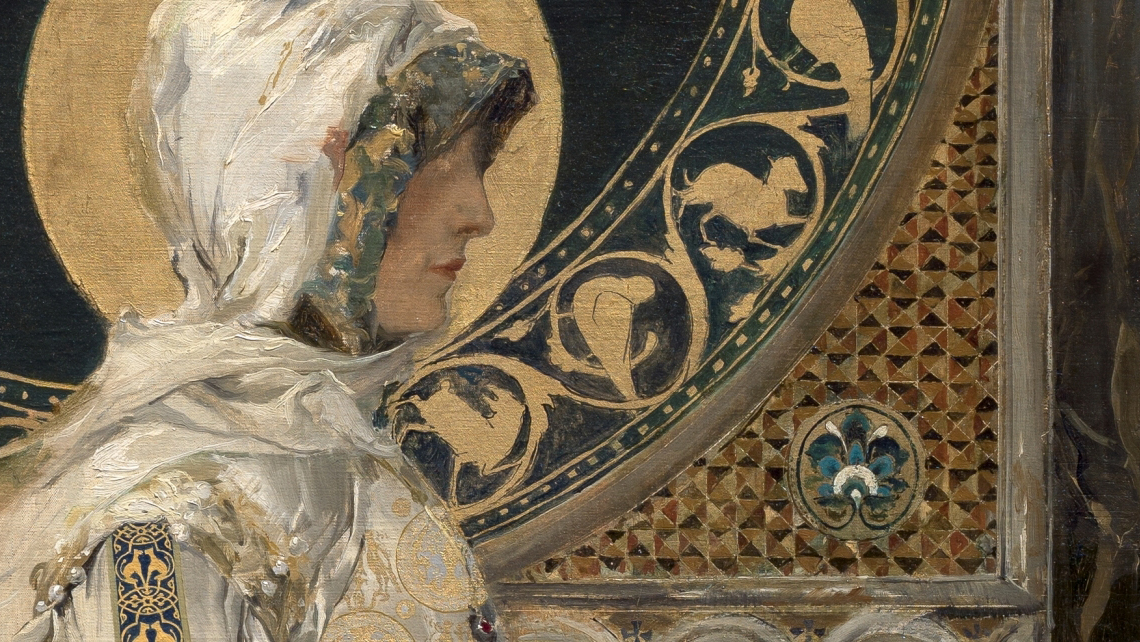What attracts us to the saints, compelling us to venerate them?
We venerate them because they are exemplars of discipleship. They show us what living “in Christ” looks like in every age, in every state in life, and so on. They fought the good fight, and whenever we think of them, we are inspired to imitate them. And to imitate them is, as St. Paul says (1 Cor. 1:11), to imitate Christ.
We venerate them because they love us and manifest that love by serving as intercessors with Christ in the heavenly kingdom. They cheer us on as we strive to witness to Christ (Heb. 12:1-2).
We venerate them because some of them desire to become our intimate friends. Patron saints are not just the God-commissioned benefactors assigned to our united category of need, but men and women of flesh and blood who wish to befriend us. I can personally attest to this with vehemence.
All that said, Eamon Duffy, in his book Faith of Our Fathers, argues a really assaulting point. He says that saints in the premodern world were mostly venerated not because they were good examples but because they were “wholly other” wild prodigies and awe-inspiring miracle workers.
Unlike most contemporary saintly portrayals, Duffy argues, the more saints of times past were unlike the rest of us, the better. In other words, odder = better. Saints bring to our common lives the uncommon and dissonant mystery of God. Saints allow ordinary folks to see and touch the transcendent in reliquaries filled with bones, blood, flesh, hair, and clothing. They reveal to us that the “stuff” of this world is, bit by bit, being translated into the world to come. The body of a saint is a locus of an unpredictable and supernatural power that threatens to, at any moment, rip open the veils of time and space.
Duffy contends that the new model of sainthood as “moral hero” runs the danger of either fostering Pelagianism, which he defines as “a wearisome emphasis on good deeds and moral effort that makes of the saint a prig and puritan,” or rendering saints so much “like us” that we fail to look on them in stunned amazement. In his view, the older model is truer to a faith founded on the Resurrection, offering us saints who are celestial tightrope walkers, ascetic stars, brutally tortured martyrs, and eccentrics who dare to transgress the inaccessible light that threatens to transubstantiate not only the bread and wine but the whole cosmos. Even the litany of faithful saints found in Hebrews 11:29-38 seems to betray all propriety:
By faith the people crossed the Red Sea as if on dry land; but the Egyptians, when they attempted to do the same, were drowned. By faith the walls of Jericho fell down after they had been encircled for seven days. By faith Rahab the harlot did not perish with those who were disobedient, because she had given friendly welcome to the spies.
And what more shall I say? For time would fail me to tell of Gideon, Barak, Samson, Jephthah, of David and Samuel and the prophets—who through faith conquered kingdoms, enforced justice, received promises, stopped the mouths of lions, quenched raging fire, escaped the edge of the sword, won strength out of weakness, became mighty in war, put foreign armies to flight.
Women received their dead by resurrection. Some were tortured, refusing to accept release, that they might rise again to a better life. Others suffered mocking and scourging, and even chains and imprisonment. They were stoned, they were sawn in two, they were killed with the sword; they went about in skins of sheep and goats, destitute, afflicted, ill-treated—of whom the world was not worthy—wandering over deserts and mountains, and in dens and caves of the earth.
While some of the change in tone has resulted from a more critical historical scholarship that excises the legendary elements of traditional hagiography, the deeper roots of this shift, Duffy argues, are to be found in modernity’s exclusion of the supernatural and miraculous from the acceptable horizons of empirical reason. It’s easier to talk to twenty-first-century rational empiricists about saints who were great humanitarians than it is to speak of saints who levitated, raised the dead, lived on the Eucharist alone, or who had bleeding holes in their hands.
Unless the data of faith is allowed into the purview of critical reason, we lose all of the explanatory power required to make any sense of supernatural events and persons that seem only to violate nature or to stand as unsolved remainders awaiting future developments in science that will finally explain them exhaustively in empirical terms. For people of faith, however, miracles are not merely anomalies or violations of the laws that govern nature, but they are proleptic intimations of the ultimate destiny of a cosmos that is being re-created in the risen and exalted Christ (cf. Rom. 8:19-20).
While all of the Catholic reasons for venerating saints need to be balanced, maybe we need to attend more to the God of the Odd and the Christ of Folly. Maybe such veneration will restore to our faith a more vertical orientation, and punch some sizable holes in modernity’s silicon ceiling and linoleum floor.
This piece was originally published on October 27, 2015 in the Word on Fire Blog.
